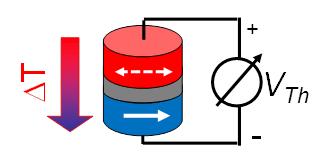Using waste heat to control microprocessors
October 25, 2011

Schematic drawing of a magnetic tunnel structure with a tunnel magneto thermoelectric voltage (credit: Schumacher/PTB)
The heat in microprocessors can be converted from a problem to a solution, due to an thermoelectric effect recently discovered in nanoelectronic magnetic tunnel structures by researchers at Physikalisch-Technische Bundesanstalt (PTB).
Magnetic tunnel structures are used, for example, as magnetic storage cells in non-volatile magnetic memory chips (“MRAMs” or magnetic random access memories) or as highly sensitive magnetic sensors to read out the data stored on hard disks.
The new effect discovered at PTB could in the future allow for monitoring and controlling thermoelectric voltages and currents in integrated circuits.
Magnetic tunnel structures consist of two magnetic layers separated only by a thin insulation layer of about 1 nm, the “tunnel barrier.” If the magnetic moments of the two layers are parallel to each other, the resistance is low; if they are opposed to each other, the resistance is high. The change in the resistance when switching the magnetization can amount to more than 100 %. So it’s possible to control the electric current flowing through the magnetic tunnel structure efficiently by simply switching the magnetization.
The PTB researchers have now found that besides the electric current, the thermal current flowing through the tunnel structure can also be influenced by switching the magnetization. In their experiments, the scientists raised the temperature difference between the two magnetic layers, generating a thermoelectric voltage. It turned out that the thermoelectric voltage depends on the magnetic orientation of the two layers nearly as strongly as the electric resistance. By switching the magnetization, it is possible to control the thermoelectric voltage and, ultimately, also the thermal current.
In the future, this new effect could be used to convert the energy of waste heat occurring in integrated circuits in a targeted way. The discovery of this “tunnel magneto thermoelectric voltage” is a milestone in the research field “spin calorics,” according to PTB researchers.
Ref.: Liebing, N.; Serrano-Guisan, S.; Rott, K.; Reiss, G.; Langer, J.; Ocker, B.; Schumacher, H.W., Tunneling magneto power in magnetic tunnel junction nanopillars, Phys. Rev. Lett. 107, 177201 (2011)